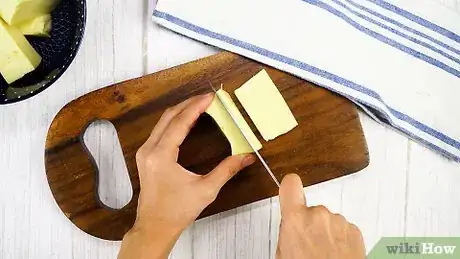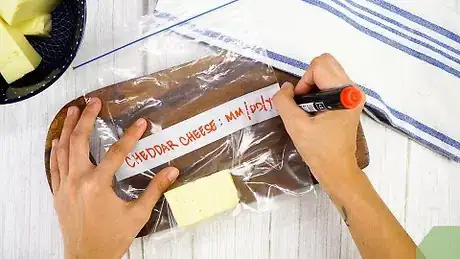This article was co-authored by Ollie George Cigliano. Ollie George Cigliano is a Private Chef, Food Educator, and Owner of Ollie George Cooks, based in Long Beach, California. With over 20 years of experience, she specializes in utilizing fresh, fun ingredients and mixing traditional and innovative cooking techniques. Ollie George holds a BA in Comparative Literature from The University of California, Berkeley, and a Nutrition and Healthy Living Certificate from eCornell University.
There are 8 references cited in this article, which can be found at the bottom of the page.
wikiHow marks an article as reader-approved once it receives enough positive feedback. This article has 23 testimonials from our readers, earning it our reader-approved status.
This article has been viewed 492,544 times.
Many types of cheeses can be frozen for about 2 to 6 months with little trouble. Seal small blocks, slices, or grated cheeses in airtight packaging before popping them in the freezer. While storing moist cheeses or special artisanal varieties in the freezer isn’t recommended, block cheese from the deli freezes very well. While the texture will become grainier, the flavor should remain the same. For this reason, you’ll want to melt down the cheese in a cooked dish or use it as a crumbly topping instead of snacking on the thawed-out slices.
Steps
Freezing Sliced or Shredded Cheese
-
1Shred or slice the cheese to make melting easier later on. If you plan to use a block of medium to very hard cheese in a cooked dish in the future, cut it into smaller pieces before freezing it. Use a cheese grater or a shredding blade on a food processor to shred the block of cheese into fine slivers. Or use a cheese knife to cut individual slices.[1]
- Prepackaged shredded or sliced cheese can easily be frozen, too. Just make sure it’s within its expiration date and doesn’t show any signs of mold.
-
2Store shredded cheese in a resealable plastic bag. If you shredded the cheese yourself, place it all in a zip-top plastic bag. For prepackaged cheese, make a small opening in the packaging. Gently squeeze the bag to expel as much excess air as possible, and then reseal it tightly.[2]
- If necessary, place the bag into a second freezer bag for an airtight seal.
Advertisement -
3Slide parchment paper in between cheese slices before you wrap them up. When freezing pre-sliced cheese or pieces you sliced yourself, cut out 1 rectangular piece of parchment paper per each slice of cheese you have.[3] Leave the paper about 1⁄2 in (1.3 cm) larger than the cheese slice so that it’s easier to separate the pieces once they’re frozen. Then form a stack of alternating between individual pieces of cheese and parchment paper.
- Once your stack is ready, seal it up in an airtight packaging as you would with a block of cheese.
- When you want to retrieve a few slices of cheese from the frozen stack, pull up on the parchment paper to separate as many slices as you want.
-
4Date and label the package before you freeze it. Use a permanent marker to write down which type of cheese is in the package. List the product’s expiration date and the date that you packaged it up and popped it in the freezer, too, so you know how long it will still be good. Once you’ve labeled the package, store it in a dry spot in your freezer until you want to defrost it.
Preparing Blocks of Cheese for Freezing
-
1Cut larger blocks down to 1⁄2 lb (0.23 kg) pieces. Avoid putting a huge wheel of cheese directly into the freezer; you’ll need to cut it down into pieces first. If you’re working with a large block or wheel of cheese, slice it into pieces weighing no more than 1⁄2 lb (0.23 kg). Depending on how you’ll eventually use the cheese, you can cut it into smaller blocks if you prefer.[4]
- This will enable the cheese to freeze and thaw out thoroughly.
-
2Wrap blocks of cheese in plastic wrapping for an airtight seal. Use plastic food wrap or a zip-top plastic bag, or a food-safe vacuum-sealed package to store the cheese. Wrap it tightly around the block of cheese and eliminate as much air as possible to prevent freezer burn.[5] Place the wrapped cheese into a freezer bag to add an extra layer of protection.[6]
- Be sure to use moisture-resistant packaging.[7]
- If the block of cheese already weighs 1⁄2 lb (0.23 kg) or less, leave it in its original packaging and add an extra layer of protection with a freezer bag.
-
3Label and date the packaged cheese before you place it in the freezer. So that you know what type of cheese you’ve frozen and how long it’s been in the freezer, use a permanent marker to jot down the product name. Add the expiration date as well as the date that you wrapped it up. Then place it in a dry spot your freezer.
- Keep the freezer door closed so that the cheese has the chance to freeze quickly and completely.
Thawing Frozen Cheese
-
1Use frozen cheese within 2 to 6 months. Keep softer natural cheeses like Gouda, Gruyère, and brie frozen for no more than 2 months. For harder cheeses and processed block cheeses, feel free to keep them frozen for up to 6 months.[8] Refer to the date you listed on the packaging and discard the cheese if you haven’t used it up after 6 months’ time.
- Keep in mind that shredded cheese and any cheese produced with holes like Swiss or fissures like blue cheese may be more prone to freezer burn. Check in on them from time to time so they don’t go bad.
-
2Defrost the cheese in the refrigerator for 24 to 48 hours. Before you consume the cheese, you’ll need to allow the ice crystals to thaw out and restore moisture to the cheese. Leave shredded or thinly sliced cheese in the fridge for at least 24 hours. For thick slices and blocks, wait around 2 days to allow the cheese to thaw completely.[9]
- Take out only as much cheese as you plan to use in the next few days. If you’re using shredded cheese, open the bag and shake or break off the amount you’ll need. Or peel off a few slices by pulling on the parchment paper. Then reseal the packaging and return the rest to the freezer.
- If you’ve frozen a block of cheese, you’ll need to defrost the whole thing.
-
3Cook with or consume the thawed cheese within 2 to 3 days. Even if the expiration date isn’t for a while, you should consume the defrosted cheese as quickly as possible for the best results. Use it in a baked dish like pizza, lasagna, or a casserole, melt it over a burger or pan of nachos, or use it as a crumbled salad topping to retain the thawed cheese’s flavor while avoiding its mealy consistency.[10] However you use it, be sure to finish it off within the next few days.
- After a 3-day period, discard any remaining thawed-out cheese that you haven’t used.[11]
Determining Which Cheeses to Freeze
-
1Freeze processed cheeses as shredded pieces, slices, or blocks. Processed block cheeses that you can buy from the deli such as cheddar, provolone, low-moisture mozzarella, Colby Jack, and others are great for freezing. Whether you buy them from the deli or prepackaged, freeze these types of cheeses in small blocks, slices, or in a shredded format.[12]
- These varieties tend to melt easily, so try using them in a cooked dish once thawed.
-
2Store hard and aged natural cheeses in the freezer for a crumbly result. Before you freeze hard or aged natural cheeses, consider how long you plan to store them and how you’ll want to consume them. Aged cheese varieties like pecorino, asiago, parmesan, and blue cheese can be frozen shredded or in small blocks.[13] Once frozen and thawed, they’ll become crumblier, so they’re best used in a cooked dish or as a crumbled topping.
- You can even freeze hard cheese rinds (like parmigiano reggiano) to add to your soups later.
- Since many aged cheeses can last for up to 4 months in the refrigerator, freezing may not be necessary.[14]
- If you’re planning to freeze blue cheese for 6 months and plan to use it as a crumbled salad topping, freezing should be no problem.
-
3Freeze soft natural cheeses if you plan to use them in a cooked dish. Soft natural cheeses like brie can be frozen, but will often take on a grainy and watery consistency. Therefore, you’ll only want to freeze soft cheeses if you’ll be melting or cooking with the thawed results.[15]
- If you want to spread a soft cheese on crackers, keep it in the fridge to retain its flavor and texture.
- It’s typically okay to freeze soft natural cheeses as part of a prepared dish, since they’ll melt during the cooking or reheating process.
-
4Refrain from freezing moist cheeses. Keep varieties like cottage cheese, ricotta, and cream cheese in the refrigerator and use them up by the expiration date listed on the packaging.[16] Similarly, avoid freezing any cheese that is typically stored in water, such as fresh mozzarella balls or burrata.[17]
- Freezing will disrupt the delicate textures and flavors. Depending on the type of cheese, it will either become dry and chunky or weepy and watery once defrosted.
- It’s usually fine to freeze these cheeses as part of a dish, such as lasagna or casserole.
- Cheesecake can be successfully frozen as the cream cheese has been baked.
Community Q&A
-
QuestionIs it possible to freeze gruyere cheese?
 Community AnswerWhen you freeze cheese, the moisture inside the cheese will crystallize and alter the microstructure of the cheese. Technically, it is possible to freeze gruyere cheese, but if the question is "Is it possible to freeze gruyere cheese and have it thaw out exactly like it was before," the answer is "no."
Community AnswerWhen you freeze cheese, the moisture inside the cheese will crystallize and alter the microstructure of the cheese. Technically, it is possible to freeze gruyere cheese, but if the question is "Is it possible to freeze gruyere cheese and have it thaw out exactly like it was before," the answer is "no." -
QuestionCan I freeze American sliced cheese?
 Community AnswerWe do freeze American cheese typically when we buy a 5 lb block, however it will sometimes crumble after it is thawed in the fridge.
Community AnswerWe do freeze American cheese typically when we buy a 5 lb block, however it will sometimes crumble after it is thawed in the fridge. -
QuestionWhat else can I use If I don't have parchment paper to put between the cheese slices?
 Community AnswerUse wax paper or plastic wrap between each slice.
Community AnswerUse wax paper or plastic wrap between each slice.
Things You’ll Need
- Cheese knife
- Cheese grater
- Plastic wrap or aluminum foil
- Plastic zip-top bags
- Freezer bags
- Permanent marker
References
- ↑ https://dairygood.org/content/2016/can-you-freeze-cheese?ref=www.nationaldairycouncil.org
- ↑ https://www.tasteofhome.com/article/can-you-freeze-cheese/
- ↑ https://www.tasteofhome.com/article/can-you-freeze-cheese/
- ↑ https://dairygood.org/content/2016/can-you-freeze-cheese?ref=www.nationaldairycouncil.org
- ↑ https://www.cooksillustrated.com/how_tos/6699-yes-you-can-freeze-cheese
- ↑ https://dairygood.org/content/2016/can-you-freeze-cheese?ref=www.nationaldairycouncil.org
- ↑ https://hgic.clemson.edu/factsheet/handling-of-cheese-for-safety-quality/
- ↑ https://hgic.clemson.edu/factsheet/handling-of-cheese-for-safety-quality/
- ↑ https://dairygood.org/content/2016/can-you-freeze-cheese?ref=www.nationaldairycouncil.org
- ↑ https://www.dairydiscoveryzone.com/blog/how-freeze-milk-cheese-yogurt-and-other-dairy-foods
- ↑ https://www.southernliving.com/dairy/cheese/can-you-freeze-cheese
- ↑ https://www.southernliving.com/dairy/cheese/can-you-freeze-cheese
- ↑ https://www.southernliving.com/dairy/cheese/can-you-freeze-cheese
- ↑ https://www.thekitchn.com/can-you-should-you-do-you-free-117893
- ↑ https://www.tasteofhome.com/article/can-you-freeze-cheese/
- ↑ https://www.thriftyfun.com/tf/Food_Tips_and_Info/Freezing/Dairy/Freezing-Cheese.html
- ↑ https://www.southernliving.com/dairy/cheese/can-you-freeze-cheese
About This Article
The best way to freeze cheese is by cutting it into blocks that are smaller than 1 pound. Once you have a manageable-sized block, wrap it in aluminum foil or plastic wrap, and place the cheese in a resealable freezer bag. Press out any excess air before you seal the bag tightly, and write the date on the bag to ensure freshness. Place the cheese in the freezer where it will last for up to 6 months. Before using your frozen cheese, place it in the refrigerator to thaw slowly! For more tips, including how to freeze shredded cheese, read on!































































